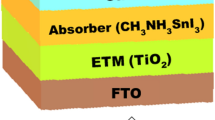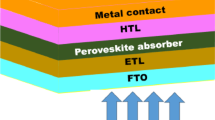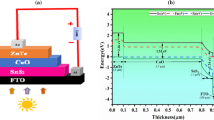Abstract
Although heat dissipation has a significant influence on the performance and reliability of solar cells, there is little research on it. An extended three-dimensional simulation of the thermal behaviour of Sn-based perovskite solar cells (PSCs) without a hole transport layer is presented for the first time. The primary purpose of this work is to simulate transient operating conditions based on temperature-dependent heat dissipation efficiency. In this study, a transient model is established by COMSOL software, and the effects of light intensity, ambient temperature, solar radiation, Joule heating, and non-radiation composite sources on Sn-based PSCs were studied by coupling the model with a Multiphysics module. Secondly, the top and back electrodes, which are helpful in reducing the working temperature, are selected to enhance the thermal stability. The maximum operating temperature of the device in the original FTO/Au contact group is 46.8 °C after integrating all the thermal sources. In the nine electrode contact groups composed of fluorine tin oxide (FTO), indium tin oxide (ITO), Al:ZnO (AZO), Au, Ag, and reduced graphene oxide (RGO) electrodes, the thermal structure with FTO as the top electrode and RGO as the back electrode is the better choice, and the heat dissipation effect is the best. This design realized that the maximum operating temperature of the device was significantly reduced to 31.1 °C. Compared with the traditional FTO/Au contact combination, the total heat was reduced by 33.6%. More fantastic play to the advantages of Sn-based PSCs photoelectric conversion efficiency. Studies have shown that enhancing the stability of Sn-based PSCs requires accelerating the heat dissipation at the bottom of the PSCs, improving the reliability of the PSCs in normal working temperatures.







Similar content being viewed by others
Data Availability Statement
This manuscript has associated data in a data repository. [Authors’ comment: The datasets generated during and analysed during the current study are available from the corresponding author on reasonable request.]
References
N.S. Kumar, K. Naidu, A review on perovskite solar cells (PSCs), materials and applications. J. Materiomics 7(5), 17 (2021)
National Center for Photovoltaics (NCPV), National Renewable Energy Laboratory (NREL); 2019 6.https://www.nrel.gov/pv/assets/images/thumb-best-research-cellefficiencies-190416.png
J. Ming-Gang, M. Chen, Y. Zhou et al., Earth-abundant nontoxic titanium(iv)-based vacancy-ordered double perovskite halides with tunable 1.0 to 1.8 eV bandgaps for photovoltaic applications. Chem. Chem. (2018). https://doi.org/10.1038/s41467-019-08918-3
W. Ke, M.G. Kanatzidis, Prospects for low-toxicity lead-free perovskite solar cells. Nat. Commun. (2019). https://doi.org/10.1038/s41467-019-08918-3
W. Ke, C.C. Stoumpos, M.G. Kanatzidis, “Unleaded” perovskites: status quo and future prospects of tin-based perovskite solar cells. Adv. Mater. 31, 1803230 (2019)
S. Shao, J. Liu, G. Portale et al., Highly reproducible sn-based hybrid perovskite solar cells with 9% efficiency. Adv. Energy Mater. 8, 1702019 (2018)
H.H. Fang, S. Adjokatse, S. Shao, J. Even, M.A. Loi, Long-lived hot-carrier light emission and large blue shift in formamidinium tin triiodide perovskites. Nat. Commun. 9(1), 243 (2018)
C.C. Stoumpos et al., Semiconducting tin and lead iodide perovskites with organic cations: phase transitions, high mobilities, and near-infrared photoluminescent properties. Inorg. Chem. 52(15), 9019–9038 (2013)
O. Hassan, A. Francesco, A. De Filippo, W. Julia, Strong electron localization in tin halide perovskites. J. Phys. Chem. Lett. (2021). https://doi.org/10.1021/acs.jpclett.1c01326
H. Cotal, C. Fetzer, J. Boisvert et al., III-V multijunction solar cells for concentrating photovoltaics. Energy Environ. Sci. 2(2), 174–192 (2009)
G.S. Kinsey, K.M. Edmondson, Spectral response and energy output of concentrator multijunction solar cells. Prog. Photovolt. Res. Appl. 17(5), 279–288 (2010)
N.S. Kumar, K. Matty, E. Rita et al., Experimental validation of a heat transfer model for concentrating photovoltaic system. App. Therm. Eng. 33(none), 175–182 (2012)
A.O. Maka, T.S. O’Donovan, A review of thermal load and performance characterisation of a high concentrating photovoltaic (HCPV) solar receiver assembly. Sol. Energy 206, 35–51 (2020)
K. Araki, H. Uozumi, M. Yamaguchi, A simple passive cooling structure and its heat analysis for 500× concentrator PV module[C]. In IEEE photovoltaic specialists conference. IEEE, 2002, pp. 1568–1571
Z. Ye, Q. Li, Q. Zhu et al., The cooling technology of solar cells under concentrated system[C]. In Power Electronics and motion control conference, 2009. IPEMC’09. IEEE 6th International. IEEE, 2009, pp. 2193–2197
Z. Hua, X. Qiao, S. Yan et al., Effect of temperature on the efficiency of organometallic perovskite solar cells. Energy Chem. 24, 72–735 (2015)
H. Mehdizadeh-Rad, J. Singh, Influence of interfacial traps on the operating temperature of perovskite solar cells. Materials 12(17), 2727 (2019). https://doi.org/10.3390/ma12172727
A. Mishra, Z. Ahmad, I. Zimmermann et al., Effect of annealing temperature on the performance of printable carbon electrodes for perovskite solar cells. Org. Electron. 65(FEB), 375–380 (2019)
M.B. Islam, M. Yanagida, Y. Shirai et al., Highly stable semi-transparent MAPbI3 perovskite solar cells with operational output for 4000h. Sol. Energy Mater. Sol. Cells 195, 323–329 (2019)
C. Multiphysics, COMSOL Multiphysics 4.3b, User 's Guide[M], COMSOL, 39–40 (2013)
M. Jiang, J. Tang, Numerical simulation design of all-inorganic hole-transport-layer-free CsSnI3 (Sn-rich)/CsSnI3 perovskite efficient solar cells[J]. Opt. Soc. Am. B 38, 3754–3764 (2021)
J.K. Yang, B. Liang, M.J. Zhao et al., Reference of temperature and time during tempering process for non-stoichiometric FTO films. Sci. Rep. 5, 15001 (2015)
A. Wang, X.Y. Gan, J.F. Yu, Simulation of narrow-bandgap mixed Pb-Sn perovskite solar cells with inverted p-i-n structure. Opt. Mater. 12, 110751 (2020)
R. Katiyar, D.S. Bag, I. Nigam, Thermal properties of fullerene (C60) containing poly(alkyl methacrylate)s. Thermochim. Acta 557, 55–60 (2013)
M. Nakaya, S. Watanabe, J. Onoe, Control of electric, optical, thermal properties of C60 films by electron-beam irradiation. Carbon 152, 882–887 (2019)
C. Lin-Jer, L. Chia-Rong et al., Synthesis and optical properties of lead-free cesium tin halide perovskite quantum rods with high-performance solar cell application. J. Phys. Chem. Lett. 7(24), 5028 (2016)
T. Haeger, R. Heiderhoff, T. Riedl, Thermal properties of metal-halide perovskites. J. Mater. Chem. C 8(41), 14289–14311 (2020)
P. Saxena, N.E. Gorji, COMSOL simulation of heat distribution in perovskite solar cells: coupled optical–electrical-thermal 3-D analysis. Photovolt. IEEE J. of 9(6), 1693–1698 (2019)
S. Zandi, P. Saxena, M. Razaghi et al., Simulation of CZTSSe thin-film solar cells in COMSOL: three-dimensional optical, electrical, and thermal models. IEEE J. Photovol. 10(5), 1503–1507 (2020). https://doi.org/10.1109/JPHOTOV.2020.2999881
D. Alonso-Alvarez, L.F. Llin, A. Mellor et al., ITO and AZO films for low emissivity coatings in hybrid photovoltaic-thermal applications. Sol. Energy 155(10), 82–92 (2017)
Y. Zeng, T. Li, Y. Yao et al., Thermally conductive reduced graphene oxide thin films for extreme temperature sensors. Adv. Func. Mater. 29(27), 1901388 (2019)
G. Ding, C. Clavero, Silver-based low-emissivity coating technology for energy- saving window applications. Mod. Technol. Creat. Thin-film Syst. Coat. (2017). https://doi.org/10.5772/67085
S. Khanna, S. Sundaram, K.S. Reddy et al., Performance analysis of perovskite and dye-sensitized solar cells under varying operating conditions and comparison with monocrystalline silicon cell. Appl. Therm. Eng. 127, 559–565 (2017)
A. Aldossary, R. Al-Dadah et al., Technical feasibility study of passive and active cooling for concentrator PV in harsh environment. Appl. Therm. Eng. Des. Process. Equip. Econ. 100, 490 (2016)
D. Torres Lobera, S. Valkealahti, Dynamic thermal model of solar PV systems under varying climatic conditions. Sol. Energy 93(6), 183–194 (2013)
Y.A. Çengel, H. Transfer, A practical approach (McGraw-Hill, Boston, 2007)
W. Tress, K. Domanski, B. Carlsen et al., Performance of perovskite solar cells under simulated temperature-illumination real-world operating conditions. Nat. Energy 4, 568–574 (2017)
W. Ming, D. Yang et al., Formation and diffusion of metal impurities in perovskite solar cell material cH3NH3PbI3: implications on solar cell degradation and choice of electrode. Adv. Sci. 5, 1700662 (2018)
S. He, L. Qiu, D.Y. Son et al., Carbon-based electrode engineering boosts the efficiency of all low-temperature-processed perovskite solar cells. ACS Energy Lett. 4(9), 2032 (2019)
Z. Liu, P. You, C. Xie et al., Ultrathin and flexible perovskite solar cells with graphene transparent electrodes. Nano Energy 28, 151–157 (2016)
M. Yang, J. Li et al., High efficient and long-time stable planar heterojunction perovskite solar cells with doctor-bladed carbon electrode. J. Power Sources 424, 61 (2019)
Author information
Authors and Affiliations
Corresponding author
Additional information
Publisher's Note
Springer Nature remains neutral with regard to jurisdictional claims in published maps and institutional affiliations.
Rights and permissions
Springer Nature or its licensor holds exclusive rights to this article under a publishing agreement with the author(s) or other rightsholder(s); author self-archiving of the accepted manuscript version of this article is solely governed by the terms of such publishing agreement and applicable law.
About this article
Cite this article
Jiang, M., Zhang, W. & Tang, J. Transient performance modelling of ultra-thin Sn-based perovskite solar cells based on electrode contact design to improve thermal stability. Eur. Phys. J. Plus 137, 978 (2022). https://doi.org/10.1140/epjp/s13360-022-03174-9
Received:
Accepted:
Published:
DOI: https://doi.org/10.1140/epjp/s13360-022-03174-9




